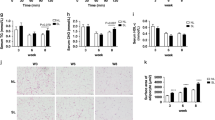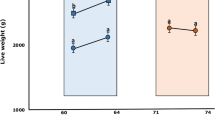Abstract
Summary: Sprague-Dawley rats were fed Purina Lab Chow with or without propylthiouracil (PTU), 0.001%. 0.01% or 0.1% PTU, ad libitum from weaning to vaginal opening. Mean values for all puhertal measurements are included in Tables 1 and 2. Growth rate (meant±5.E.) was significantly reduced (Neuman-Keuls test; P<0.05 level) in all PTU-fed rats (controls 4.9±0.1 g/day, 0.001% PTU 4.2±0.2 g/day, 0.01% PTU 3.4±0.2 g/day. 0.1% PTU 2.5±0.1 g/day), while age at vaginal opening in rats fed 0.001% PTU (35.8±0.6 days) or 0.01% PTU (36.1±0.9 days) was not significantly different from controls (36.0±0.6 days). Nevertheless, body weight at vaginal opening was lower in rats fed 0.1% PTU (87.6±4.7 g) than in controls (113.6±3.7 g). Pubertal body weight of rats fed 0.1% PTU was also reduced (88.6±3.7 g) but vaginal opening delayed (40.4±0.8 days). Proportions of body fat (6.1-5.1%). protein (15.0-14.11). and water (72.4-71.3%) at vaginal opening were the same in control and PTU groups. Serum T4 was greatly diminished and similar in all 3 PTU groups. 0.2-0.3 μg/100 ml vs 4.8±0.2 μg±100 ml in controls: in rats fed 0.1% and 0.01% PTU. T3 was 0.9±0.4 ng/100 ml and 0.9±0.6 ng/100 ml, respectively vs 72.6±5.6 ng/100 ml in controls, but not significantly reduced in the 0.001% PTU-fed group (60.7±7.9 ng/100 ml).
In a second experiment, a group of weanling rats (pair-fed) was selected in which each member was fed the daily amount of control diet eaten by a corresponding age- and weight-matched 0.01% PTU-fed rat. During the experiment, both groups maintained the same body weight, growth rate, and food intake, however, only 45% (n = 11) of the pair-fed animals had vaginal opening by the time their 0.01% PTU-fed counterparts attained first estrus. Although one of the pair-fed (undernourished) rats attained first estrus, no eggs were found. Despite greatly reduced body weight (105.3±3.5 g vs controls 127.56.6 g), growth rate (3.5±0.2 g/day vs controls 5.5±0.1 g/day) and food intake (13.9±0.7 g/100g BWt/day vs controls 10.1±0.3 g/100g BWt/day), the 0.01% PTU-féd rats exhibited vaginal opening (36.920.8 days vs controls 35.621 days) and first estrus (39.6±0.9 days vs controls 36.4±1 days) at the usual age. In contrast, pair-fed rats had a lower% fat (4.5±0.1% vs PTU 6.8±0.4%) and higher % protein (16.5±0.34 vs PTU 14.32 0.3%) at the age when 0.01% PTU-fed rats attained first estrus. Serum prolactin levels at first estrus did not differin rats fed control diet (26.5±12.4 ng/ml) or 0.01% PTU (8.8±1.9 ng/ml), or i n pair-fed animals (8.8±4.5 ng/ml) at the age when PTU-fed rats reached first estrus.
Speculation: These data show that despite low food intake and retarded growth, female rats made hypothyroid by feeding them PTU during the post-weaning period under go sexual maturation at the ususal age. This is in contrast with the delayed puberty observed in pair-fed (undernourished) animals that attain the same body weight and growth rate. The proportion of fat/lean tissue in the PTU-fed rats is indistinguishable from that in their pubertal controls, but differs greatly in pair-fed animals at that age.
Similar content being viewed by others
Log in or create a free account to read this content
Gain free access to this article, as well as selected content from this journal and more on nature.com
or
Author information
Authors and Affiliations
Rights and permissions
About this article
Cite this article
Wilen, R., Bastomsky, C. & Naftolin, F. Control of Puberty in Female Rats: The Effect of PIU-Induced Hypothyroidism and Systematic Undernutrition. Pediatr Res 15, 169–171 (1981). https://doi.org/10.1203/00006450-198102000-00019
Issue date:
DOI: https://doi.org/10.1203/00006450-198102000-00019



